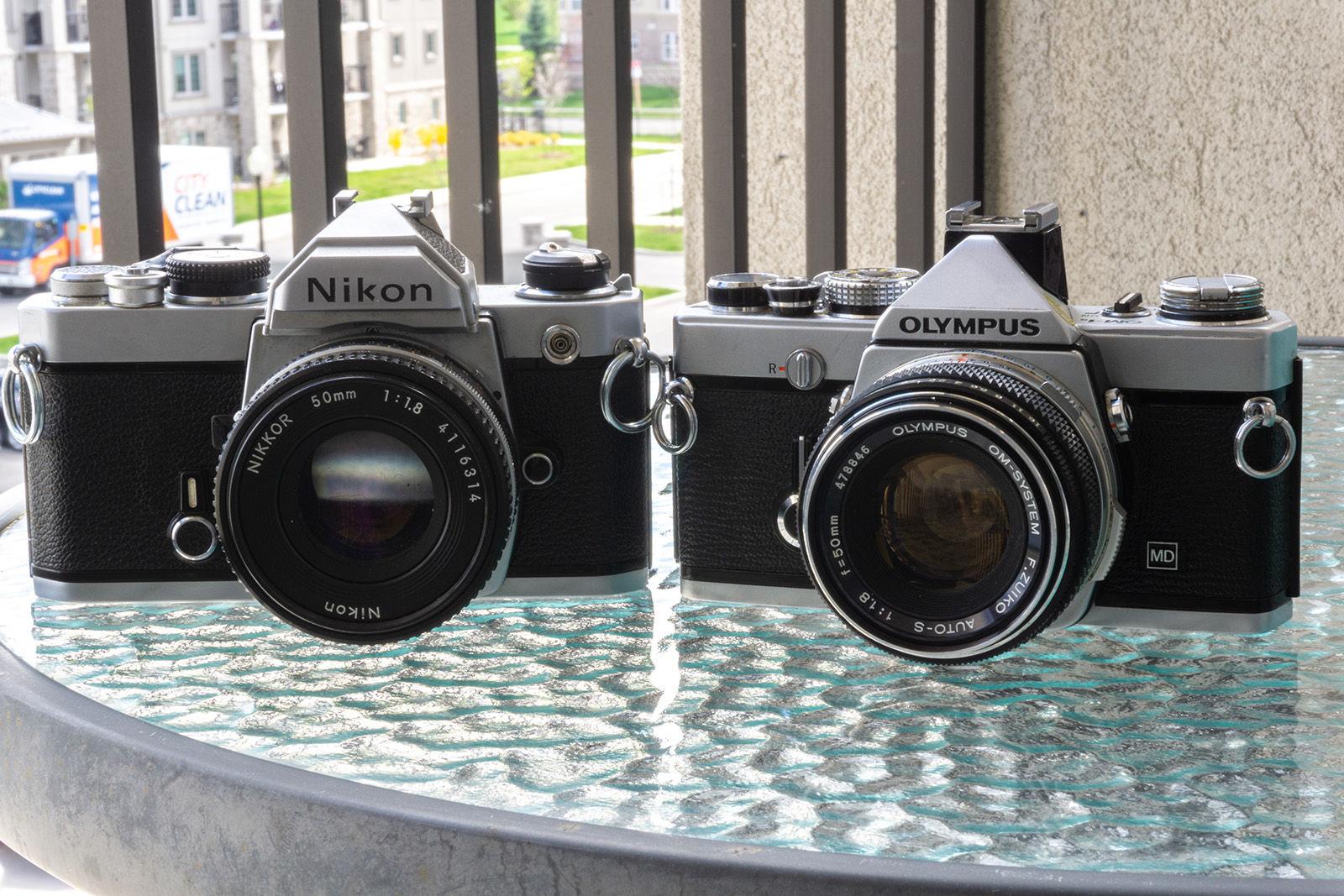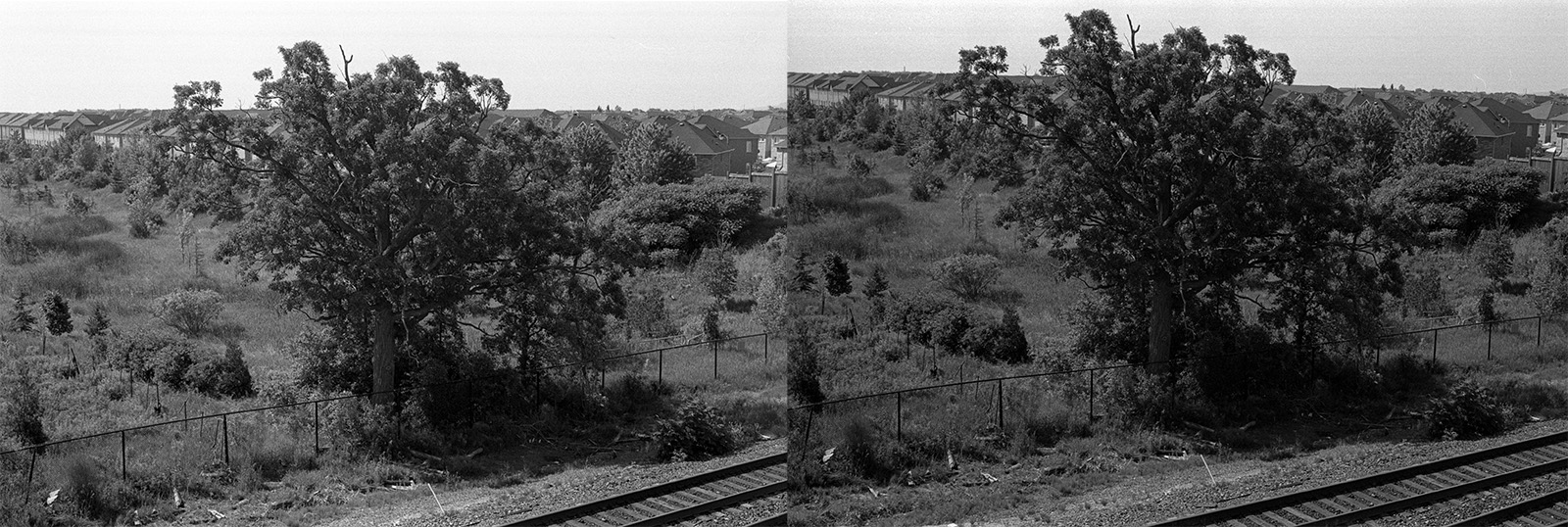It’s a rumble in the mechanical jungle! Last year I pitted my Nikon F5 against the Minolta Maxxum 9, and I had a lot of fun doing that review, not to prove which camera is better but to show the difference between the two top dog professional cameras. And I have been waiting for a chance to repeat the format for some other cameras. So why not take out two iconic small-format SLRs that came out in the 1970s, sadly I had very view from that era, at least until recently when I got a pair of them. Today we’re going to compare the Olympus OM-1n the improved version of the original OM-1 with the Nikon FM, one of many cameras that came out in the aftermath of the OM revolution. Again, as before, this isn’t to determine which camera is better, but rather to show off the differences between the two and help you choose which system to choose.

[table id=3 /]
For this review, each camera is equipped with a 50mm f/1.8 lens both the Olympus and Nikon lenses have the same optical build (6 Elements, 5 Groups) the only difference in the actual construction is the aperture blades; the Nikon has 7, the Olympus has 6. Both cameras were loaded with Eastman Double-X film, exposed at ASA-250 and developed in Kodak D-76 (1+1) for ten minutes. Sadly the meter in the OM-1n is not working (battery), so to even the odds, I ran with the ReveniLabs Meter on the OM-1n and the stock meter in the Nikon FM. In the comparison images, the images shot on the Nikon FM will be on the left side and the OM-1n on the right side.

Ergonomics – Camera Feel
Despite being so close in size, the two cameras have a radically different feel in hand. Both cameras are very close in size and only 10 grams difference in weight, with the OM-1n being the smaller and lighter of the two. But the way they sit and balance in hand and around the next feel very different. The Nikon FM feels like a smaller Nikkormat, no surprise as it came out as a direct successor to that line of cameras whereas the OM-1n is light and well balanced in hand. Amazing how much 10g will feel in hand. When it comes to the controls and layout, both cameras are different yet well laid out at the same time. I cannot pick which one is generally easier to operate in the field as I’m used to both interfaces by this point. But if you’re used to one or the other switching can be a little troublesome. See, on the Olympus, the shutter speed dial is around the lens mount, but it is smooth with just a slight resistance to indicate the stops, at least there is a clear separation between speeds and the apertures which are at the edge of the lens barrel. Whereas on the Nikon has the shutter speed dial on the top of the camera body and has solid clicks when you set the shutter speed. The film advances are both comfortable in hand, although the OM-1n does have a longer stroke than the Nikon. But having that more massive build with the FM, I would be more likely to take the FM into a battle zone than the OM-1n. But in terms of ergonomics and feel I give a slight edge to the OM-1n, it has a much smoother feel to the camera and its operations.


Experience – Out and About
The most significant difference between the two cameras comes with when you’re out in the field with them. While the weight and size are about equal and both feel excellent in hand. However, in the area, I have to say the FM does edge out over the OM-1n. First, the FM has far more feedback in the viewfinder than the OM-1n, the FM does have the shutter speed and aperture displayed inside the viewer, the OM-1n has only the match needle. No indication of your camera’s settings. The FM also has, as I mentioned before, has a much shorter stroke on the film advance but a much heavier one. While the OM-1n is longer but far smoother, I would not want to use either camera in low light as both lacks any sort of illumination. Although the FM does use the three diodes, you need to memorise what each one indicates. Although the FM system, I would prefer the match-needle of the OM-1n. The viewfinder in the OM-1n is brighter than the FM, but I think if my FM’s finder were a little cleaner, they would be about equal. The FM also has a far more satisfying shutter sound having that metal bladed Copal Square Shutter certainly has a sense of finality that the OM-1n lacks. However, in some situations, a quiet shutter is not a bad thing. Both are joys to use in the field, but not at the same time as both have radically different control layouts, and I often found myself struggling to adapt quickly between the two. But I certainly like having that extra feedback in the viewfinder the FM gives.


Image Quality
When it comes to image quality, there are two separate parts I want to talk about. The first is exposure; now I can’t compare the two meters equally as the OM-1n was not using its stock CdS meter, instead, I used a ReveniLabs unit. And here’s the most significant difference between the two. I found that with the OM-1n/ReveniLabs saw some losses in the shadows and often metered a good stop under what I got with the Nikon FM. Thankfully the film has enough latitude that it didn’t matter. When it comes to exposure, I will have to give the edge to the FM only for better capture of both highlights and shadows. The second factor is image sharpness, and here the two are about equal, about equal. But after a closer look between the two, I do have to give the edge to the Zuiko glass, both lenses although equal optically and in many cases, I was shooting at about f/16, I just found that the Olympus images are just a touch sharper than what I got out of the Nikkor glass.


The Final Verdict
I have to admit; this verses post has been a hard one to write because unlike the F5 versus the Maxxum 9. Both cameras are excellent and reliable choices when out in the field. I guess it all comes down to selection in the end. When it comes to the overall layout and functionality, I have to give the edge to the Nikon FM as you get a lot more feedback in the viewfinder and having a more traditional design to the controls. Plus having that nice short film advance is a certain plus. I also found the GPD a little more sensitive than the CdS cells. But when it comes to optics, as hard as it is to say, the Zuiko glass certainly outshines the Nikkor lenses. I’ve come to like both cameras and certainly can’t wait to explore both systems more, especially the OM-System.
1 Comment